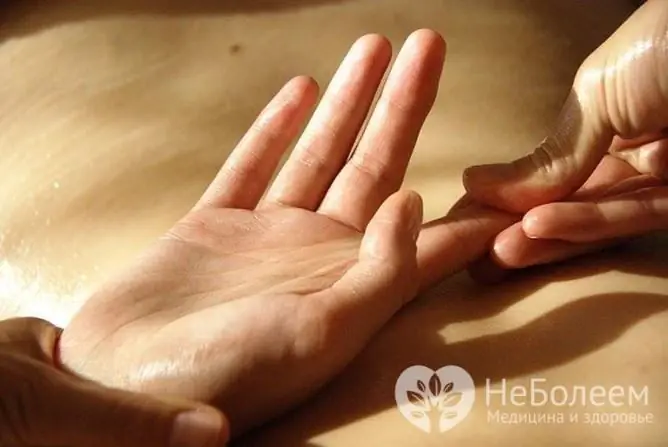- Author Rachel Wainwright [email protected].
- Public 2024-01-15 19:51.
- Last modified 2025-11-02 20:14.
Why fingertips go numb and what to do
The content of the article:
- The reasons
-
Treatment
- Features of treatment for Raynaud's disease
- Features of treatment for carpal tunnel syndrome
- Features of treatment for osteochondrosis
- Features of treatment for Dupuytren's contracture
- Features of treatment for multiple sclerosis
- Features of treatment for Guillain-Barré syndrome
- Video
The fingertips on the hands become numb due to a variety of external and internal factors. In the pathogenesis of numbness are disorders of nerve conduction and blood supply in the extremities. This type of sensitivity disorder is only a symptom of the underlying disease and usually resolves after a course of appropriate treatment.
Pathology does not depend on gender or age.

The tips of your fingers can go numb due to various medical conditions.
The reasons
The causes of numbness in the fingertips are due to various diseases of organs and systems. This complicates the diagnosis and often stretches the diagnostic search. Most likely:
| The reasons | Explanation |
| Raynaud's disease | Pathology is associated with impaired blood circulation in the right and left extremities. There are several options for the development of this disease. In the first case, the syndrome is associated with vasospasm (spastic form), the second option is associated with complete paralysis of the neurovascular bundle (angioparalytic form). In the third case, in connection with paralysis, multiple trophic ulcers and tissue necrosis (trophoparalytic form) develop. The phenomenon of spasm, as a rule, is short-lived and reversible (with the exception of the trophoparalytic form). |
| Carpal tunnel syndrome |
The main patient groups are office workers, seamstresses (occupational disease). In this case, a person has a constant load on the wrist joints and, as a result, pinching of the median nerve. |
| Traumatic injuries and their complications (incorrect bone fusion, chronic fractures) | In this case, numbness is caused by deformed bone structures pressing on the neurovascular plexus. In the case of an acute injury, a fracture. In case of injury, numbness may be the result of cutting the nerve endings with bone fragments (the hand loses sensitivity). |
| Diseases of the musculoskeletal system (osteochondrosis) | A tingling sensation is characteristic of osteochondrosis of both the upper limb girdle and the upper spine (cervical, thoracic). In the case of a lesion of the cervical spine, the violation of sensitivity begins to spread along a downward path (neck, shoulders, forearms, fingers) |
| Vascular thrombosis of the upper extremities |
The pads of the fingers grow numb. Pathology is rare and often occurs in people with chronic renal failure. The reason for this is that hemodialysis must be done through a vessel of a relatively large caliber (radial, ulnar or median artery). |
| Intervertebral hernia | They may have such a symptom as numbness of the upper limbs, one of the first possible complaints. But in this case, the hernia should be localized in the upper parts of the spinal column, and their more frequent localization is the thoracolumbar or lumbar region. |
| Dupuytren's contracture (palmar fibromatosis) | The disease is associated with fibrous degeneration of the flexor tendons - they pass along the palmar surface of the hand-fingers. Shortening of the flexors leads to impaired motor activity and innervation. One of the fingers of the hand (index, ring) is more often affected. |
| Multiple sclerosis | A disease associated with focal damage to the myelin sheath, which envelops nerve fibers in the brain. In this case, numbness will be associated with a violation of the centers of sensitivity to the cortex. |
| Myocardial infarction | In the classic version, the left limb becomes numb and partial paralysis of the facial nerve occurs. In more rare cases, numbness will be only on the side of the fingers of the hands (complicates the diagnosis). |
| Stroke | One of the main symptoms will be loss of sensation, regardless of the degree of hemorrhage in the brain (total, subtotal, subcapsular). |
| Guillain-Barré Syndrome | Polyradiculoneuritis, associated with the destruction of nerve endings by the body's own antibodies (autoimmune process). It is accompanied by sensitive disorders, paralysis and paresis. |
There are also conditions that lead to short-term numbness without the presence of a particular disease:
- vitamin deficiency;
- obesity;
- alcoholic neuropathy;
- professional sports (especially the load of tennis players means a lot);
- pregnancy;
- hypothermia.
The phenomenon of numbness can be short-term (as a rule, does not require treatment and disappears without a trace) and long-term.
Treatment
Before prescribing treatment, a thorough diagnosis is required (self-medication is unacceptable). Therapy, regardless of the cause, includes:
- medications (tablets, injections, gels and ointments);
- physiotherapy;
- Exercise therapy and massage;
- surgical intervention.
Features of treatment for Raynaud's disease
Specialists for consultation - vascular surgeon, cardiologist.
Treatment regimen:
- Drug therapy - vasodilators.
- Surgery involves the removal of abnormal nerve tissue that causes abnormal vasoconstriction (sympathectomy).
The prognosis is relatively favorable (prolonged remission phase).
Features of treatment for carpal tunnel syndrome
Specialists for consultation - neurologist, trauma surgeon.
Treatment regimen:
- Drug therapy - non-steroidal anti-inflammatory drugs, corticosteroids, pain relievers.
- Orthopedic devices (orthoses, bandages).
- Physiotherapy - phonophoresis with non-steroidal anti-inflammatory drugs, laser therapy.
- Surgical intervention involves the dissection of the ligaments that exert pressure on the neurovascular bundle. Conducted under local anesthesia.
The forecast is favorable. The recurrence rate is 5-10%.
Features of treatment for osteochondrosis
Specialists for consultation - neurologist, trauma surgeon.
The scheme includes the following methods:
- Drug therapy - non-steroidal anti-inflammatory drugs, chondroprotectors, bisphosphonates.
- Physiotherapy - electrophoresis, UHF, magnetotherapy, cryotherapy.
- Exercise therapy and massage.
- Surgical intervention - arthroscopy, puncture, endoprosthetics.
The prognosis is relatively favorable (pathology is often chronic).
Features of treatment for Dupuytren's contracture
The specialist for consultation is a traumatologist surgeon, a doctor of radiation diagnostics, a neurologist.
Treatment regimen:
- Physiotherapy - electrophoresis, magnetotherapy, X-ray radiation.
- Exercise therapy and massage.
- Collagen injections (semi-surgical treatment).
- Surgical intervention - separation of contractures (selective fasciectomy, percutaneous needle fasciotomy). Maybe under both general and local anesthesia.
The prognosis is relatively favorable. The recurrence rate after surgery is 30%.
Features of treatment for multiple sclerosis
The specialist for consultation is a neurologist, immunologist, physiotherapist. Multiple sclerosis does not have an established exact cause and is characterized by a slow, systematic and irreversible destruction of nerve tissue. Therapy for this disease will depend on the form (remitting, primary progressive, secondary progressive).
Treatment regimen:
- Drug therapy - immunosuppressants, cytostatics, steroid hormones.
- Exercise therapy (mandatory).
- Physiotherapy - electromyostimulation, magnetotherapy, electrophoresis.
Treatment is strictly individual and subject to constant correction (it is extremely difficult to find).
Exacerbation phase:
- Drug therapy of the underlying disease - interferons (immunomodulators), immunoglobulin, corticosteroids (pulse therapy).
- Drug therapy for concomitant diseases caused by the treatment of the main one (damage to the optic nerve, pain syndrome, bowel disorders) - pain relievers, enzymes, probiotics.
The prognosis is extremely unfavorable. There is no complete recovery. Treatment is aimed at delaying progression.
Features of treatment for Guillain-Barré syndrome
The specialist for consultation is a neurologist, a cardiologist (in the acute phase, immediate transfer to the intensive care unit is indicated).
Approximate treatment regimen:
- Drug therapy - immunoglobulin, corticosteroids, heparin.
- Physiotherapy-magnetotherapy, paraffin applications, electrical stimulation.
- Exercise therapy and massage.
- Anesthetic and surgical intervention - intubation with the setting of a nasogatral probe, plasmapheresis.
An extremely serious illness with severe impairment of the cardiovascular and respiratory system (bulbar palsy). The prognosis is poor.
Video
We offer for viewing a video on the topic of the article.

Anna Kozlova Medical journalist About the author
Education: Rostov State Medical University, specialty "General Medicine".
Found a mistake in the text? Select it and press Ctrl + Enter.






